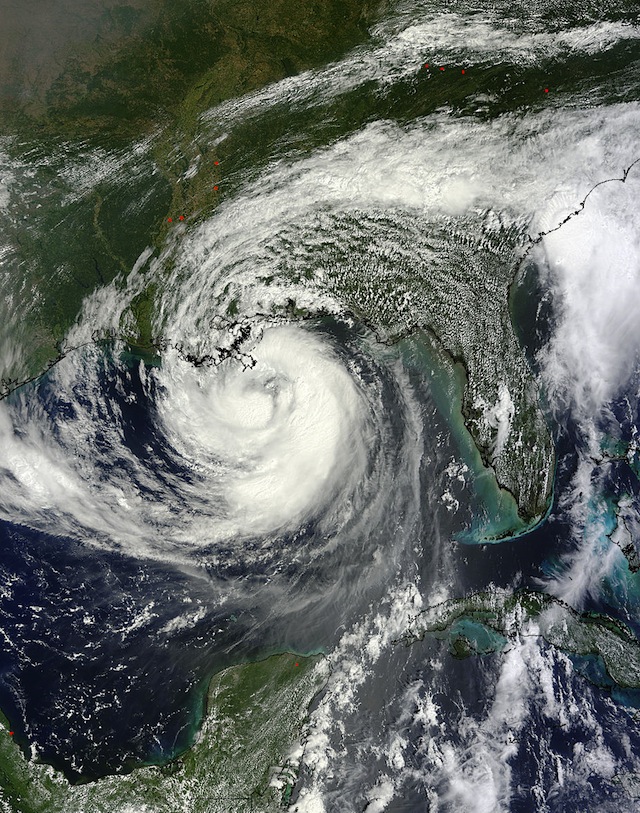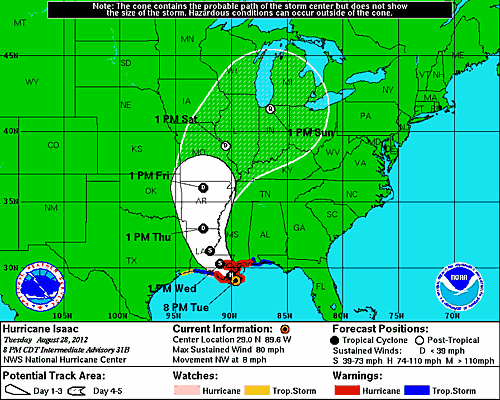SUMMARY
This is AI generated summarization, which may have errors. For context, always refer to the full article.

NEW ORLEANS, Louisiana, United States – Hurricane Isaac on Tuesday, August 28 (Wednesday, August 29 in Manila) made landfall in Louisiana and barreled towards New Orleans, seven years after Hurricane Katrina devastated the “Big Easy” and killed 1,800 people on the US Gulf Coast.
Isaac, which reached hurricane strength earlier in the day and was packing maximum sustained winds of 80 miles (130 kilometers) per hour, lashed the area with heavy rains and strong winds, as residents hunkered down.
The US National Hurricane Center said the category one storm had generated a “dangerous storm surge” along the northern Gulf Coast, with surges of up to 9.5 feet (2.9 meters) reported in Louisiana, Mississippi and Florida.
States of emergency were declared in Louisiana and Mississippi, allowing authorities to coordinate disaster relief and seek emergency federal funds.
More than 4,000 members of the Louisiana National Guard were activated, with 48 boat teams deployed around New Orleans, according to the office of governor Bobby Jindal, who had warned residents to prepare for the worst.
New Orleans Mayor Mitch Landrieu said the city could expect up to 16 inches (40 centimeters) of rain or more because the hurricane was moving slowly over the area.
“We have dodged a bullet in the sense that this is not a category three storm,” he said, “But a category one at this strength… is plenty big enough to put a big hurt on you if you fall into complacency. Let’s not do that.”
US President Barack Obama urged people to take the threat seriously, warning of the possibility of major flooding and damage.
“I want to encourage all residents of the Gulf Coast to listen to your local officials and follow their directions, including if they tell you to evacuate,” Obama said.
“Now is not the time to tempt fate. Now is not the time to dismiss official warnings. You need to take this seriously.”
Obama said he had managed a wide-ranging effort by federal and local governments to make preparations.

His televised appearance showed the power of an incumbent to intervene at politically advantageous moments, just as Republicans met to nominate Mitt Romney as their candidate for the November presidential election.
A full-blown hurricane warning remained in effect for metropolitan New Orleans, a city known as the Big Easy for its jazz and easy-going life-style.
Isaac’s powerful winds downed power lines — Entergy New Orleans said on its website that more than 120,000 customers were affected.
As of 0100 GMT Wednesday, the hurricane was “moving slowly” northwest along the Louisiana coast and its eye was about 75 miles (120 kilometers) southeast of New Orleans, the center said.
“Some slight strengthening is possible before Isaac moves inland,” it said.
The US Coast Guard said it had closed major ports along the Gulf Coast, and shut down navigation on the Mississippi from Baton Rouge, Louisiana to the mouth of the river.
Jindal said his state contacted Washington about getting reimbursed for hurricane-preparation spending — an allusion to agonizing delays in getting federal help after Katrina blasted the city.
“We sent a letter yesterday to the president. We have learned from past experiences that you can’t wait. You have to push the federal bureaucracy,” Jindal said.
While most New Orleans residents heeded calls to hunker down in their homes, a steady stream of more adventurous souls headed to the banks of Lake Pontchartrain to feel the power of the wind and watch the crashing waves.
“It’s awesome!” Scott Schneider, 40, told AFP after climbing down a grass-covered levee to get a picture of the flooded lakefront park.
Dozens of die-hards also spilled into the handful of bars still open in the famed French Quarter, but the streets were practically deserted as heavier rains and darkness fell.
The timing of the storm — set to bear down on New Orleans on the seventh anniversary of Katrina — nevertheless had many here on edge.
“It brings back a whole lot of memories,” said Melody Barkum, 56, who spent days stranded on a roof without food or water after Katrina struck. “I’m not afraid. If I can survive Katrina, I can survive this.”
Katrina left behind a devastating sprawl of destruction and death when it hit New Orleans on August 29, 2005, and a bungled response by the Bush administration tarnished the president’s second term in office.
Thousands of people were left stranded on the roofs of their houses for days after Katrina’s storm surge smashed levees long-warned to be inadequate, flooding 80 percent of the low-lying city.
Those who made it to dry land faced deadly violence and looting as the city descended into chaos and officials failed to even provide water and food — let alone security and medical aid — in the sweltering heat.
Officials insisted billions of dollars spent to reinforce the city’s storm levees and pumps will protect the Big Easy from inundation this time, and Isaac is nowhere near Katrina’s strength.
Mandatory evacuations were ordered in a number of coastal counties in Louisiana and Alabama, where people typically build their homes on stilts.
The slow-moving and massive storm could dump as much as 20 inches (50 centimeters) of rain on isolated areas and spawn tornadoes, the NHC warned. – Mira Oberman, Agence France-Presse
Add a comment
How does this make you feel?
There are no comments yet. Add your comment to start the conversation.